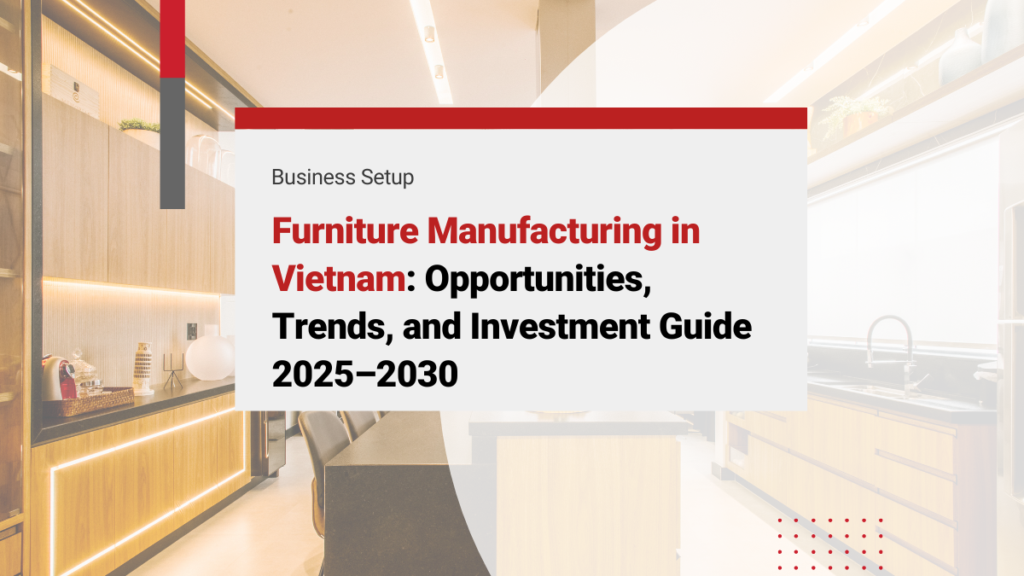Vietnam has become a major global furniture manufacturing hub, offering affordable production, an increasingly skilled workforce, and strong export performance. In 2024, Vietnam remained Southeast Asia’s largest furniture exporter, with wood and furniture exports reaching US$16–17 billion. This growth—despite global market fluctuations—signals strong opportunities for international startups and SMEs entering the sector. To succeed, investors must understand key industry trends such as technology adoption, sustainable materials, labor shifts, and compliance, as well as practical considerations like regulations, regional manufacturing hubs, infrastructure, and potential risks. This 2025–2030 guide provides the essential insights needed to navigate Vietnam’s furniture manufacturing landscape with confidence.
Vietnam is now the largest furniture exporter to the United States, capturing around 37% of U.S. furniture import value in 2024. This marks a major shift in global sourcing, with Vietnam surpassing even China in the American market. Strong demand from the U.S. – which accounts for more than half of Vietnam’s total furniture exports – continues to be a major engine behind the sector’s rapid growth.
Setting up a manufacturing operation in Vietnam? Explore InCorp Vietnam’s all-in-one business setup and outsourcing services
Vietnam’s Furniture Manufacturing Industry: Overview and Recent Performance
Vietnam’s furniture industry has grown into a global “silent giant,” supported by over 5,000 factories and 600,000+ workers. Though dominated by SMEs, steady foreign investment has accelerated technology adoption and boosted production capacity, helping Vietnam emerge as a top-tier exporter beyond the “China+1” label.
After a brief slowdown in 2023, the sector rebounded strongly in 2024. Forestry exports reached about US$17.3 billion, with timber and furniture contributing roughly US$16.3 billion. Key categories such as wooden chairs, living room sets, bedroom furniture, and wood panels each generated over US$1 billion. The U.S. remained the biggest market, taking around 55% of exports, followed by Japan, South Korea, China, and the EU (supported by EVFTA tariff cuts).
Despite global headwinds, Vietnam’s wood and furniture industry posted a trade surplus of about US$14.4 billion in 2024, with export targets set to reach US$18 billion in 2025. Today, Vietnam stands among the most competitive and resilient furniture manufacturing hubs worldwide.
Current Trends in Vietnam’s Furniture Industry (2025)
Staying competitive in the global furniture market requires Vietnam’s industry to continuously evolve. Several key trends in furniture manufacturing are shaping the landscape in 2025, which will likely define the trajectory through 2030. These include rapid technology adoption, a shift toward sustainable materials and practices, changes in labor dynamics, and strategic market diversification. Understanding these trends will help investors and new entrants align with Vietnam’s industry direction.
Technology Adoption and Industry 4.0 in Furniture Manufacturing
Vietnamese furniture manufacturers are rapidly adopting Industry 4.0 technologies, from advanced machinery to digital production tools. At BIFA WOOD Vietnam 2025, local firms showcased automation, CNC systems, robotics, and AI-driven solutions—highlighting the sector’s strong push to modernize and reduce manual labor.
Many exporters now use virtual showrooms, AR-based product previews, and blockchain traceability to improve design customization, transparency, and compliance in global supply chains. Government and industry associations continue to support these upgrades to boost efficiency and product quality.
The shift, however, creates new challenges. A shortage of skilled workers able to operate and maintain advanced systems is putting pressure on employers, leading to more training initiatives and demand for technical expertise. Overall, Vietnam’s furniture industry is moving quickly from low-cost manual production toward a smarter, more automated, and digitally driven manufacturing model.
Sustainable Materials and Green Manufacturing Practices
Sustainability is becoming a core driver of Vietnam’s furniture industry. Manufacturers are increasing their use of responsibly sourced wood, supported by more than 520,000 hectares of FSC-certified forests and a national goal to reach 1 million hectares by 2030. This shift helps exporters meet strict requirements like the EU Timber Regulation and the EU Deforestation Regulation.
Producers are also adopting greener materials—such as bamboo, rattan, reclaimed wood, and recycled plastics—while improving factory operations through solar energy, biomass systems, waste reduction, and water-saving processes. Vietnam’s growing focus on sustainable production is strengthening its position as a leading hub for eco-friendly, compliant, and globally competitive furniture manufacturing.
Labor Dynamics: Workforce, Costs, and Skill Development
Vietnam’s labor force remains a major advantage for the furniture industry, offering a large, young, and experienced pool of workers skilled in woodworking. The sector employs hundreds of thousands of people, especially in rural areas, and labor costs remain highly competitive: factory workers typically earn US$250–$450 per month, compared with US$420–$450 in the Philippines. This cost gap can translate into 25–40% savings in furniture production.
However, labor dynamics are changing. Wages are rising, and automation is creating strong demand for workers with technical and machinery skills. Manufacturers are investing more in training, while global buyers increasingly expect compliance with international labor standards. Competition for skilled talent is also growing across Vietnam’s broader manufacturing sectors.
Even so, Vietnam’s young demographics and steady supply of vocational graduates support long-term labor needs. As the industry shifts from low-cost labor toward higher productivity and tech-enabled operations, investors should expect to prioritize upskilling and workforce development to stay competitive.
Market Shifts and Diversification of Export Markets
Vietnam’s furniture industry is quickly diversifying its export markets and product range after the 2025 U.S. tariff scare, which exposed the risks of relying heavily on a single market. While the final tariff settled at 20% for most goods, the episode pushed manufacturers to expand beyond the U.S.
Exports to Japan and South Korea have surged, with Japan up over 20% in early 2025. Northeast Asia and China now account for 30–40% of total exports, while EVFTA-driven tariff cuts are boosting shipments to Europe. Companies are also targeting high-growth markets like the Middle East and India with tailored product designs.
At the same time, producers are broadening their product mix—from traditional wooden furniture to modular and ready-to-assemble systems, eco-friendly panels, and niche items like wooden toys and kitchenware.
Overall, the sector is becoming more resilient by spreading risk across multiple export destinations and moving into higher-value product categories.
Investment Guide 2025–2030: How to Succeed in Vietnam’s Furniture Manufacturing Sector
For foreign startups and SMEs considering investment in Vietnam’s furniture manufacturing industry, the outlook is undeniably attractive. Yet, achieving success requires navigating the regulatory landscape, choosing the right entry strategy, understanding regional clusters, leveraging logistics infrastructure, and preparing for challenges. Below is a breakdown of these considerations to guide investors from 2025 to 2030.
Regulatory Landscape and Business Environment
Vietnam provides a welcoming regulatory environment for foreign investors in furniture manufacturing, allowing 100% foreign ownership and actively promoting export-oriented projects. Its network of 17+ FTAs—including CPTPP, RCEP, EVFTA, and agreements with the UK, Japan, South Korea, ASEAN, and the 2024 Vietnam–UAE CEPA—gives “Made in Vietnam” furniture broad tariff-free or low-duty access. EVFTA alone reduces EU tariffs on Vietnamese furniture to 0%, strengthening competitiveness.
Locally, manufacturers must comply with strict rules on legal timber use and sustainability. The Forestry Development Strategy 2021–2030 and Vietnam’s FLEGT agreement with the EU require full timber traceability and ban illegal wood. Environmental regulations on waste, emissions, and noise are also tightening, though many industrial parks provide shared treatment facilities to support compliance.
Tax incentives are available for projects in encouraged sectors or in less-developed provinces, offering potential corporate income tax holidays or reductions. Vietnam continues to streamline business registration and customs procedures, though newcomers still benefit from professional guidance.
Overall, Vietnam’s regulatory landscape is FDI-friendly, sustainability-focused, and strongly supported by global trade agreements—making it an attractive base for long-term furniture manufacturing investment.
Market Entry Strategies for Startups and SMEs
Entering Vietnam’s furniture market can be done through several practical pathways, depending on a company’s goals and resources.
1. Partnering with local manufacturers (Joint Ventures / Partnerships)
This is a common option for SMEs. Working with an established Vietnamese factory allows foreign firms to use existing facilities, labor, supplier networks, and regulatory know-how. It reduces upfront investment and accelerates market entry, especially if the foreign partner brings technology, design capabilities, or export channels.
2. Setting up a wholly foreign-owned enterprise (WFOE)
A WFOE gives full control but requires greater investment—securing factory space, hiring workers, and meeting licensing requirements. Vietnam’s industrial parks help streamline this process by offering ready-built factories and one-stop investment support.
3. Contract manufacturing / OEM
For businesses not ready to build a factory, OEM production is an efficient entry route. Many global brands—including major U.S. and European retailers—already rely on Vietnamese manufacturers for high-volume, high-quality output. Startups often begin with sourcing and move to deeper investment once demand scales.
4. Leveraging industry networks and trade events
Joining associations like HAWA or VIFOREST provides access to partners, suppliers, and policy updates. Trade fairs such as VIFA Expo (Ho Chi Minh City) and BIFA Wood (Binh Duong) are key platforms for meeting manufacturers and buyers.
5. Exploring e-commerce collaboration
Vietnamese suppliers are increasingly active on global platforms like Amazon, where exports by local SMEs have grown over 50% annually. Foreign SMEs can co-develop private-label or direct-to-consumer product lines using Vietnamese production.
6. Building the right local team
Hiring bilingual staff or local advisors helps navigate permits, customs, and cultural nuances. Relationship-building remains essential in Vietnam’s business environment.
Overall, whether through partnerships, OEM sourcing, or establishing a full manufacturing presence, SMEs can integrate smoothly into Vietnam’s fast-growing furniture ecosystem with a well-planned entry strategy.
Regional Manufacturing Hubs: Binh Duong, Dong Nai, Quang Nam and Beyond
Choosing the right location is a key strategic step for furniture manufacturing in Vietnam, as the industry is concentrated in several major hubs, each with different strengths.
Southern Vietnam (Binh Duong & Dong Nai – the main hub)
This region is the center of Vietnam’s furniture industry. Binh Duong is widely known as the country’s “furniture capital,” with dense industrial parks, a deep labor pool, and many foreign-invested factories. Its proximity to Ho Chi Minh City provides easy access to suppliers and services, while nearby ports—Cat Lai and the deep-water Cai Mep–Thi Vai—offer strong logistics for exporting bulky goods directly to major global markets. Infrastructure is highly developed, and the upcoming Long Thanh International Airport will further improve cargo capacity. For most foreign investors, the south offers the fastest setup and most complete ecosystem.
Central Vietnam (Quang Nam, Binh Dinh, Thua Thien-Hue – rising manufacturing zones)
The central region is gaining momentum thanks to lower labor and land costs, access to raw materials from nearby plantation forests, and tax incentives in economic zones like Chu Lai. Quang Nam and Binh Dinh have growing clusters of export-oriented factories, supported by ports such as Da Nang and Quy Nhon. While industrial infrastructure is not yet as mature as the south, the region provides a good balance of costs, logistics, and available workforce. It’s increasingly chosen by mid-sized factories and companies seeking geographic diversification within Vietnam.
Northern Vietnam (Hanoi region, Ha Nam, Bac Ninh, Thai Binh – strategic but smaller cluster)
The north has smaller furniture clusters but remains attractive for companies targeting Northeast Asian markets. Exports via Hai Phong Port make shipping to Japan, Korea, and China efficient. Proximity to China also enables easy access to machinery and materials. Some investors adopt a China-plus-Vietnam strategy and choose the northern provinces for operational alignment. The main trade-offs are colder climate conditions affecting wood drying and a less concentrated furniture ecosystem compared to the south.
Key takeaway
Binh Duong–Dong Nai is the strongest and most established hub, ideal for quick setup and deep supply chains. Central Vietnam offers lower costs and room for expansion, while the north provides strategic access to East Asia and China-linked supply routes. Many foreign SMEs begin in the south and later expand to central or northern regions as they scale—a strategy increasingly supported by improving highways and nationwide logistics upgrades.
Logistics Infrastructure and Export Pipeline
Vietnam’s strong logistics and infrastructure network is a major advantage for furniture manufacturing, helping companies move raw materials in and finished products out efficiently.
Seaports – the backbone of exports
The south hosts Vietnam’s most critical export gateways. Cat Lai Terminal handles large volumes, while Cai Mep–Thi Vai Deep Sea Port offers direct shipping to the U.S. and Europe—crucial for bulky furniture that benefits from fewer transshipments and lower costs. In the central region, Da Nang and Quy Nhon ports support exporters, and in the north, Hai Phong Port serves as the main hub. While port efficiency has improved, businesses should still plan for seasonal congestion and work with reliable freight forwarders.
Roads and infrastructure – improving nationwide connectivity
Vietnam continues to upgrade highways, including major segments of the North–South Expressway. These connections make trucking between industrial hubs and ports faster and more predictable. In the south, expressways link Binh Duong and Dong Nai to HCMC ports, and the new Long Thanh International Airport will expand air freight options for samples and high-value items. Industrial parks generally provide strong internal infrastructure, supported by expanding logistics parks and 3PL services.
Supply chain inputs – imports remain essential
Vietnam produces plantation-grown acacia, rubberwood, and pine but still relies heavily on imported wood and materials. In 2024, timber imports from the U.S. exceeded US$300 million, alongside imports of hardware, fabrics, leather, and chemicals. Import procedures have improved through e-customs, but investors must comply with phytosanitary rules for wood. Maintaining drying kilns, warehouses, and stable supplier relationships helps manage supply fluctuations.
Export procedures – streamlined but compliance-heavy
Vietnam has simplified customs processes, yet wood exporters must maintain strong documentation for legality—such as FLEGT requirements for the EU and Lacey Act declarations for the U.S. Shipping times to major markets (e.g., 3–4 weeks to the U.S. West Coast) are comparable to China. While logistics costs are still higher than some developed countries, global carriers operate widely in Vietnam, ensuring ample options for SMEs.
Looking for product registration, import-clearance or trademark protection for your manufacturing business in Vietnam? InCorp Vietnam offers complete support for your global brand.
Foreign Direct Investment and Financing Considerations
Vietnam’s furniture sector continues to attract strong foreign investment, with 2024 showing a 7% rise in new FDI projects and a more than 73% jump in total capital inflows. This surge reflects growing confidence in Vietnam as a long-term manufacturing base. Much of the new capital is going into modernizing factories—adding advanced machinery, improving finishing lines, and installing renewable energy solutions like rooftop solar.
For foreign SMEs, Vietnam allows full profit repatriation (after taxes), and the VND remains stable and convertible for trade. Many investors combine equity with local bank loans, as Vietnamese banks increasingly finance export-oriented FDI projects at competitive rates. Others secure support from development finance institutions or export credit agencies, especially for sustainability-focused investments.
Investors should still conduct thorough due diligence. Joint ventures require strong shareholder agreements, and intellectual property protection—particularly for furniture designs—should be secured through timely registration. Compliance costs also need budgeting, from fire safety requirements to environmental assessments and certifications like FSC-CoC for exporters.
Vietnam’s FDI landscape includes both large global brands and SMEs that have scaled significantly after establishing local operations. With the right preparation and commitment to quality, foreign investors can benefit from Vietnam’s cost efficiency, export advantages, and fast-growing furniture market.
Potential Challenges and How to Mitigate Them
Vietnam offers strong opportunities in furniture manufacturing, but investors should be aware of several challenges and prepare accordingly for 2025–2030.
Trade policy risks
Events like the 2025 U.S. tariff scare highlight Vietnam’s vulnerability to shifts in major markets.
Mitigation: Diversify export destinations using Vietnam’s FTAs, strengthen compliance messaging, and stay engaged with industry associations that advocate on trade issues.
Rising costs and regional competition
Labor and land costs are climbing, while competitors such as Indonesia and Malaysia are improving their manufacturing capabilities.
Mitigation: Boost productivity through automation, lean processes, and worker training. Focus on higher-value segments where design and quality matter more than low-cost production.
Raw material constraints
Growing sustainability requirements limit timber sourcing and expose manufacturers to global price swings for imported wood.
Mitigation: Build a diversified supplier network, including domestic plantations and overseas exporters. Consider investing in FSC-certified plantations or using alternative materials like bamboo and engineered composites.
Infrastructure bottlenecks
Ports, roads, and utilities—though improving—can still face congestion or intermittent issues.
Mitigation: Choose industrial parks with reliable infrastructure, maintain backup power solutions, and plan shipments early to avoid peak-season delays.
Regulatory and ESG pressures
Global buyers require strict environmental and social compliance. SMEs must meet standards on legal wood, labor practices, and safety.
Mitigation: Implement compliance systems early, pursue certifications such as BSCI/SMETA, and monitor environmental footprints to meet buyer expectations.
Cultural and managerial challenges
Foreign investors may experience differences in communication and workplace culture.
Mitigation: Hire bilingual managers, invest in cultural understanding, and build strong relationships with local teams.
By identifying these challenges early and applying structured mitigation strategies, investors can operate more confidently and sustainably in Vietnam’s fast-growing furniture manufacturing sector.






